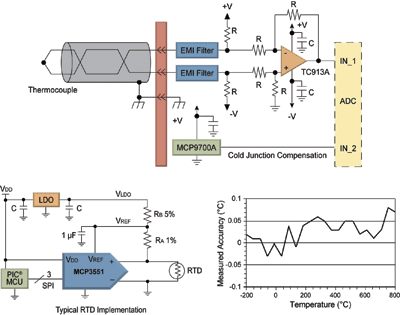Adopting Si temp sensors in today’s electronics
The advantages and disadvantages over other temperature-sensing options
BY JOHN AUSTIN
Senior Product Marketing Manager
Analog & Interface Products Div.
Microchip Technology
www.microchip.com
Silicon-based temperature sensors have gained popularity over the past decade. Not only are they more commonly used in modern electronics, these devices are rapidly expanding into new applications that historically did not have a temperature sensor, or that used other temperature-sensing methods, such as thermocouples or RTDs. This article discusses why the industry is trending toward using silicon temperature sensors across many applications and markets. Advantage and disadvantages of silicon-based temperature sensors vs. other temperature-sensing options will be reviewed. The article will also present several example applications that can benefit from the added features and increased functionality of modern silicon temperature-sensor solutions.
So, why are silicon temperature-sensing solutions gaining so much popularity in electronics, today? One popular reason is that silicon temperature sensors are simple devices—they require very little knowledge of thermal design. Additionally, silicon temperature sensors have many integrated features that give designers the flexibility to add more functionality to their end application. Other deciding factors may be that these devices are relatively inexpensive, or that the entire solution is very small, or that they deliver more potential power savings than traditional temperature-sensing solutions, such as thermocouples, thermistors, and RTDs. It could also be the fact that the accuracy of these sensors has increased dramatically in recent years. There are many possible reasons why a designer might choose to implement a silicon temperature sensor.
A slightly deeper dive into silicon temperature sensors may add more clarification to the potential benefits of these solutions. Generally, silicon temperature sensors are classified by output type — logic, voltage, and digital.
Voltage-output temperature sensors
Voltage-output temperature sensors develop an output voltage proportional to temperature, with a typical temperature coefficient of 6.25, 10, or 19.5 mV/°C. Temperature-to-voltage converters can sense a –55° to 150°C temperature range and feature temperature offset which allows the reading of negative temperatures without requiring a negative supply voltage. Typical operating currents are in the tens of microamperes, which minimizes self-heating and maximizes battery life. Voltage-output temperature sensors are similar in function to a very common temperature-sensing element, the thermistor.
Thermistors are probably the most common method used to sense temperature, today. The thermistor’s resistance changes with a corresponding change in temperature. Positive Temperature Coefficient (PTC) thermistor resistance will increase with an increase in temperature, whereas Negative Temperature Coefficient (NTC) thermistor resistance will decrease with an increase in temperature.
There are a couple of disadvantages to using a thermistor vs. a voltage-output silicon temperature sensor. First, the thermistor solution can consume orders of magnitude more power than newer silicon-based temperature sensors. Second, the thermistor is somewhat restrictive in temperature range, due to its nonlinearity. Depending upon the desired temperature range of interest, the thermistor solution can require external circuitry. This can add additional board space and increase solution cost. The silicon-based solutions are very linear over a fairly wide temperature range (–55° to 150°C), and offer solutions as small as SC70 packaging. All in all, the silicon solution may offer a smaller, lower cost, and more power-efficient solution vs. the thermistor.
Logic-output temperature sensors
Another benefit of silicon-based temperature sensors is their ability to integrate functionality. Logic-output temperature sensors typically function as a thermostat, notifying the system that a minimum or maximum temperature limit has been reached. Sometimes referred to as “temperature switches,” these devices can be used to turn on either a fan or a warning light, when high- or low-temperature conditions are detected. As the output is typically not latched, the switch will turn off when the temperature falls below or rises above the temperature set point. Most logic-output sensors have an integrated hysteresis of a few degrees Celsius, to prevent output chatter.
One way to implement this with a thermistor is to add a comparator circuit. This scenario would add errors to the system, such as offset and offset drift from the comparator. The designer would also have to accommodate for the mismatching of any resistors used in the circuit. This would most likely require a single temperature trim to calibrate the circuit. Once again, the silicon-based solution is simpler to implement. All of the trimming and calibration is done by the manufacturer.
Serial-output temperature sensors
Historically, the most common way to obtain highly accurate and very repeatable temperature measurements was to use either thermocouples or Resistive Temperature Detector (RTD) circuits. As Figure 1 shows, both of these solutions require multiple components and, to achieve high temperature accuracy or high temperature resolution, the circuits can become large, expensive and complicated.

Fig. 1: RTD instrumentation circuit block diagram and output performance.
Serial-output temperature sensors are the Cadillac of silicon temperature sensors. The most attractive attributes of digital temperature sensors are that they are simple to use and offer designers a lot of flexibility in their designs, due to the various features that are integrated into these devices. These devices use a two- or three-wire interface to the host microcontroller. They generally offer the most integration, with an onboard Analog-to-Digital Converter (ADC) that converts the analog output of the internal sensing element to a digital output. Serial-output temperature sensors can achieve temperature accuracies of ±0.25°C (typical), with a measurement resolution of 0.0625°C. With temperature accuracy of 0.25°C typical at 25°C, the MCP9804 (see Figure 2 ) is a great example of a high-accuracy, high-integration digital temperature sensor. It is offered in a 2 x 3-mm DFN package and has many features that give designers more flexibility in their application.

Fig. 2: The MCP9804 temperature sensor features high temperature accuracy of 0.25°C typical at 25°C and many features that enable greater design flexibility.
Many serial-output temperature sensors provide user-programmable functions, such as over- and under-temperature alerts and onboard EEPROM. These features can be used to simplify a design, increase its flexibility, improve temperature-sensing accuracy, and lower overall system cost.
When compared to RTD and thermocouples, the most common limitation of serial-output temperature sensors is their operating temperature range. Silicon temperature sensors are generally specified to operate from –55° to 150°C, whereas RTDs can provide an accurate solution over a few hundred degrees C and thermocouples over a couple thousand degrees Celsius.
Temperature sensors bring with them a variety of advantages and disadvantages. No one type of sensor is appropriate for all temperature-sensing applications. Application requirements must be outlined, in order to identify the appropriate sensor for a specific application.
Thermistors provide a useful, low-cost temperature-sensing solution in applications that operate over a limited temperature range. RTDs can be highly accurate over several 100s of degrees Celsius, and require careful scaling and calibration. However, an RTD solution can be quite costly when compared to thermistor or silicon-IC solutions. Thermocouples are most useful in applications that operate in extreme temperatures. Silicon IC-based temperature sensors simplify designs, while offering fairly high accuracy over a wide temperature range. They also provide many integrated features that enhance system flexibility and performance. ■
Advertisement
Learn more about Microchip Technology





